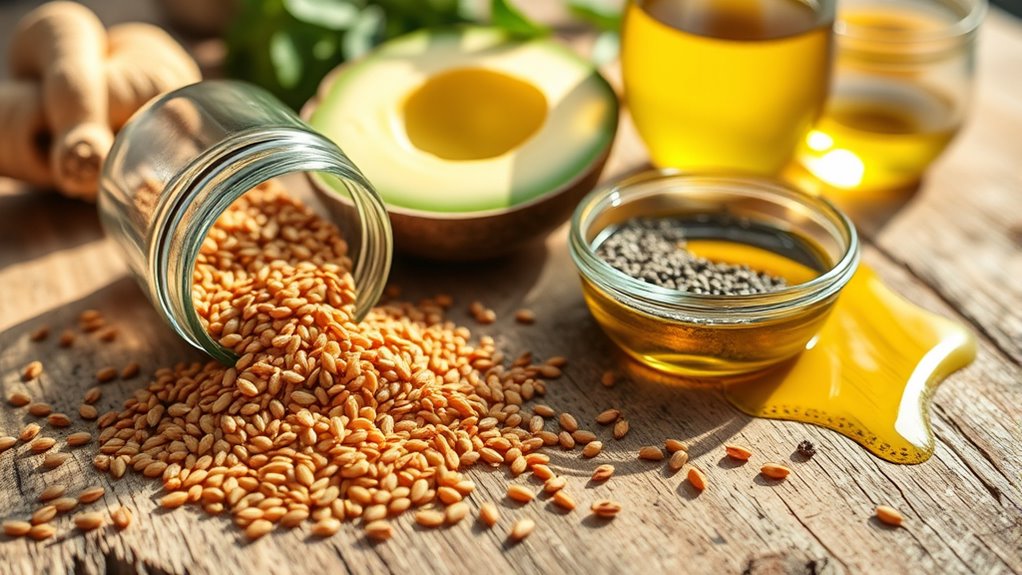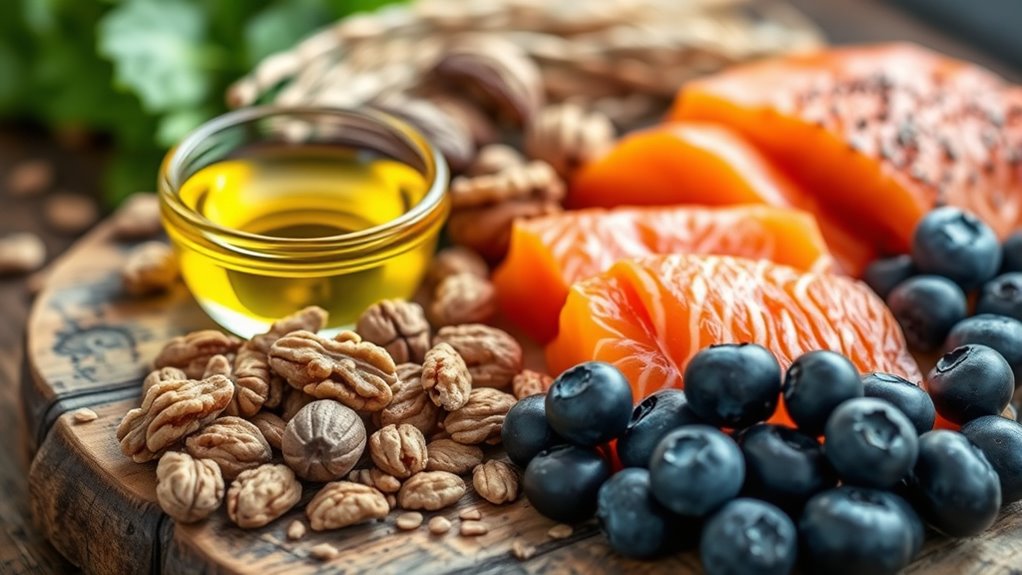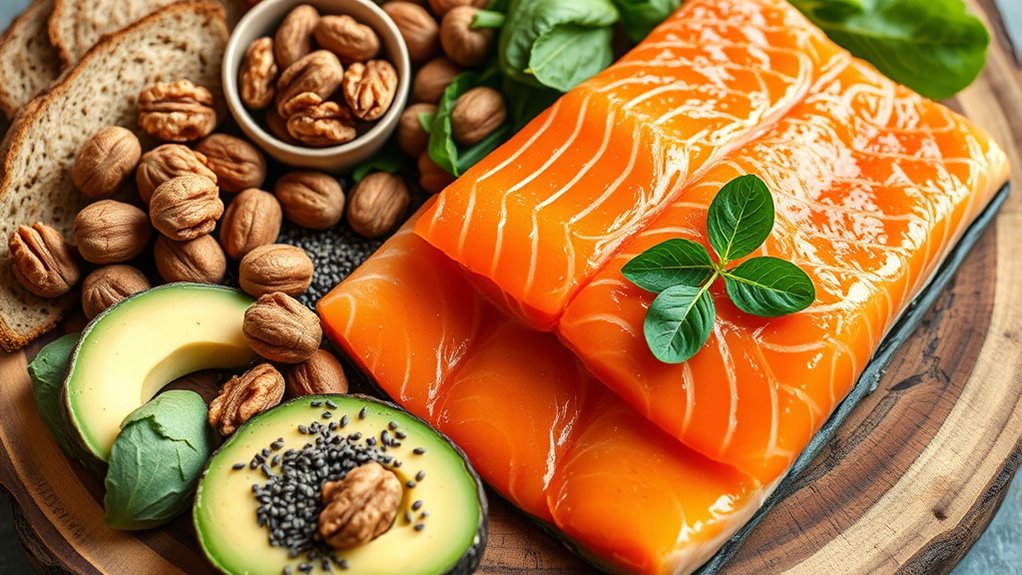Healthy fats like omega-3, 6, and 9 are essential for your brain, heart, and overall health. Omega-3s reduce inflammation and support eye and brain function, found in fatty fish and seeds. Omega-6s aid cell growth but need moderation, mostly coming from processed foods. Omega-9s improve cholesterol levels and are found in olive oil and avocados. Balancing these fats is vital, and understanding their sources helps you make smarter choices—discover more about optimizing your health with these fats.
Key Takeaways
- Healthy fats include monounsaturated (Omega-9) and polyunsaturated (Omega-3 and 6) fats essential for body functions.
- Omega-3s support brain, heart, and eye health; found in fatty fish, flaxseed, and walnuts.
- Omega-6s support skin and cell growth but should be balanced with Omega-3s to prevent inflammation.
- Omega-9s improve cholesterol and heart health naturally, present in olive oil, avocados, and nuts.
- Balancing intake and choosing whole, unprocessed sources helps maximize benefits and reduce health risks.
What Are Healthy Fats and Why Do They Matter?

Have you ever wondered why some fats are considered healthy while others are harmful? It all comes down to how your body handles dietary fats through fat metabolism. Healthy fats, like monounsaturated and polyunsaturated fats, support your body’s functions and help reduce inflammation. They’re essential for energy production, hormone regulation, and cell health. When you consume these fats, your body efficiently processes them, unlike trans fats or excessive saturated fats, which can clog arteries and increase health risks. Understanding what makes fats healthy helps you make better choices. Incorporating good fats into your diet fuels your body properly and promotes overall wellness. Paying attention to the industry trends and latest research about dietary fats can further improve your health decisions. Recognizing the types of healthy fats that are easily processed by your body can enhance your overall metabolic health. Being aware of how different fats influence inflammation and disease risk can guide you toward better dietary habits.
The Basics of Omega-3 Fatty Acids

Building on your understanding of healthy fats, omega-3 fatty acids stand out as particularly beneficial types of polyunsaturated fats. These essential fats support your body in numerous ways, including reducing inflammation and boosting heart health. The omega 3 benefits extend to improving brain function and eye health, making them vital for overall well-being. Your body can’t produce omega-3s on its own, so you need to get them through diet or supplements. They influence fatty acid synthesis, helping your cells function properly and maintain their structure. Consuming enough omega-3s guarantees your body can efficiently incorporate these fats into cell membranes, supporting ideal health at a cellular level. Additionally, understanding home decor and how to organize your space can create a more calming environment that promotes wellness. Awareness of seed allergy risks is important when incorporating various seeds into your diet, as some may trigger allergic reactions or cross-reactivity. Knowing about nutritional content helps you make smarter choices for a balanced, healthy diet, which is essential for maintaining overall health and wellness.
Understanding Omega-6 Fatty Acids

Omega-6 fatty acids are another essential type of polyunsaturated fats that play a pivotal role in your health. They support brain function, skin health, and cell growth. However, maintaining a proper Omega 6 balance is key because an excess can lead to increased inflammatory effects. When your intake tips too far toward omega-6s, it may promote inflammation, contributing to chronic diseases. To keep things in check, be mindful of your dietary sources. Consider these points:
- Balance omega-6 intake with omega-3s
- Limit processed foods high in vegetable oils
- Choose whole, unprocessed fats
- Be aware of hidden sources in snacks and baked goods
- Aim for a healthy ratio to reduce inflammatory effects
- Understanding cookie categories can help you make better choices and manage your intake effectively.
The Role of Omega-9 Fatty Acids in Your Diet

Omega-9 fatty acids are a type of monounsaturated fat that can profoundly benefit your health when included in your diet. These fats help improve your cholesterol levels, reducing the risk of heart disease, and support overall inflammation control. The Omega 9 benefits extend to better insulin sensitivity and enhanced skin health. You can find Omega 9 sources in foods like olive oil, avocados, and nuts. Incorporating these into your meals is simple and effective, making it easier to maintain a balanced diet. Unlike some other fats, Omega 9s are not essential because your body can produce them, but consuming them through healthy foods amplifies their positive effects. Prioritizing Omega 9 sources ensures you get these benefits naturally, supporting your long-term health. Additionally, understanding how to maximize space and organization in your diet and lifestyle can further enhance your overall well-being. Incorporating healthy fats into your diet can also contribute to better weight management and sustained energy levels. Furthermore, embracing creative practice in meal planning or cooking can make incorporating healthy fats more enjoyable and sustainable.
How to Identify Good Sources of Omega-3, 6, and 9

To find good sources of omega-3, 6, and 9, look for foods rich in these healthy fats, like fatty fish, nuts, and seeds. Check ingredient labels for oils such as flaxseed, chia, or olive oil, which indicate their presence. Remember, plant-based sources often provide omega-3s, while animal sources tend to offer a broader mix of these fats. Additionally, proper storage of specialty teas in airtight containers helps preserve their freshness and flavor. Incorporating a variety of plant-based sources ensures a balanced intake of these essential fatty acids.
Rich Food Sources
Identifying good sources of omega fatty acids involves paying attention to the foods you include in your diet. Rich sources naturally contain higher levels of omega-3, 6, and 9, making them easier to incorporate into your meals. To maximize health benefits, consider cooking tips that preserve omega content, like gentle baking or steaming. Flavor pairings can enhance your dishes—try adding flaxseeds to smoothies, walnuts to salads, or oily fish with citrus. Using sulfate-free shampoos can also help maintain the vibrancy and health of highlighted hair, ensuring your hair color stays radiant and protected. Additionally, selecting foods with high omega content can further boost your intake of these beneficial fats, supporting overall wellness.
Ingredient Labels Clues
How can you tell if a food is a good source of omega fats just by looking at the label? Focus on label clues and ingredient insights. Check the ingredient list for oils like flaxseed, chia, walnuts, or fish oils—these are strong indicators of omega-3 content. Look for terms like “rich in omega-3” or “contains added omega-3s,” which highlight the product’s benefits. Avoid products with hydrogenated oils or excessive amounts of refined fats, as these are less healthy. Pay attention to the nutrition facts panel, noting the amount of total fats and specific omega fats listed. Clear labeling and ingredient transparency help you quickly identify foods that are good sources of omega-3, 6, and 9, making healthier choices easier.
Plant vs. Animal
Understanding the sources of omega fatty acids can help you make healthier choices by distinguishing between plant-based and animal-based options. Plant-based fats, found in foods like flaxseeds, chia seeds, walnuts, and hemp oil, are rich in ALA (alpha-linolenic acid), a type of omega-3. Animal fats, such as fatty fish, eggs, and fish oils, provide EPA and DHA, which are more directly used by your body. Recognizing these sources enables you to balance your intake effectively.
- Plant based fats often contain ALA, a precursor to EPA and DHA.
- Animal fats supply EPA and DHA directly for better absorption.
- Plant sources are usually lower in saturated fats.
- Animal fats may contain more environmental contaminants.
- Combining both sources ensures a well-rounded omega profile for your health.
- Practicing mindfulness and self-awareness can enhance your understanding of your dietary needs and preferences.
- Being aware of bioavailability helps in choosing the most effective omega sources for your health. Additionally, understanding nutrient absorption can guide you toward optimizing your intake for maximum health benefits.
- Incorporating a variety of sources can also support nutritional diversity, which is essential for overall well-being.
Balancing Your Intake of Essential Fats

To maintain a healthy balance, focus on increasing your intake of Omega-3-rich foods like fatty fish and flaxseeds. At the same time, try to limit your consumption of Omega-6 sources, such as processed snacks and fried foods. Striking this balance helps support overall health and reduces inflammation. Incorporating SQA best practices by choosing eco-friendly packaging and locally sourced ingredients can also contribute to a healthier environment.
Prioritize Omega-3 Sources
Since your body can’t produce omega-3 fatty acids on its own, it’s vital to include rich sources in your diet to maintain ideal health. Prioritizing omega-3s helps balance your fats and supports brain, heart, and joint health. To do this, consider fat substitution by swapping out less nutritious fats for omega-3-rich options like fatty fish or flaxseeds. Use cooking techniques such as baking, steaming, or grilling instead of frying to preserve omega-3 integrity. Incorporate a variety of sources, including:
- Fatty fish (salmon, mackerel, sardines)
- Chia or flaxseeds
- Walnuts
- Hemp seeds
- Algal oil supplements
Focusing on these sources ensures your diet is optimized for essential fats and supports overall wellness. Understanding healthy fats can help you make better dietary choices. Additionally, being aware of shower installation options can enhance your bathroom’s functionality and aesthetic appeal.
Limit Excess Omega-6
While increasing your intake of omega-3s is important, it’s equally essential to keep omega-6 fatty acids in check. Too much omega-6 can lead to an imbalance that promotes inflammation, increasing health risks. Avoid falling for trans fat myths that suggest all fats are bad; instead, focus on reducing omega 6 excess from processed foods and vegetable oils. Many people unknowingly consume more omega-6 than necessary, which can negate the benefits of omega-3s. Aim for a better balance by choosing whole foods like nuts, seeds, and fatty fish, and limit processed snacks. Keeping omega-6 intake in moderation supports overall health and helps prevent chronic inflammation linked to excess omega-6 consumption.
Common Myths About Fats and Heart Health

Many people believe that all fats are bad for your heart, but this isn’t true. Not all fats negatively impact your health; some are essential for fats and metabolism and support heart health. Misconceptions often lead to avoiding fats altogether, which can harm your well-being. According to dietary fat guidelines, choosing the right fats is key.
Remember:
- Healthy fats can improve cholesterol levels.
- Not all saturated fats are harmful.
- Trans fats are the main culprits in heart disease.
- Omega-3s support cardiovascular health.
- Balance and moderation matter more than total fat intake.
Understanding these myths helps you make better choices and embrace fats that actually benefit your heart, rather than fearing all fats indiscriminately.
Tips for Incorporating Healthy Fats Into Your Meals

Incorporating healthy fats into your meals can be simple and delicious with a few smart choices. Start with smart cooking techniques, like sautéing vegetables in olive oil or adding avocados to smoothies for extra richness. Using whole foods such as nuts, seeds, and fatty fish naturally boosts your healthy fat intake. Meal planning helps you stay consistent; prepare meals ahead that feature omega-3-rich salmon or omega-6 sources like walnuts. Swap butter for healthier oils like avocado or olive oil in your recipes. Incorporate these fats into salads, grain bowls, or snacks. By thinking ahead and choosing the right cooking methods, you’ll effortlessly include healthy fats into your daily routine. This way, you enjoy their benefits without sacrificing flavor or convenience.
Recognizing Signs of Fat Deficiency and Excess

Have you ever noticed unexplained weight changes, fatigue, or skin issues? These can signal fat deficiency or excess, affecting your body’s fat absorption and metabolic effects. Signs of deficiency include dry skin, brittle nails, poor concentration, and increased hunger. Conversely, excess fat intake may lead to weight gain, digestive discomfort, and elevated cholesterol. Monitoring your body’s responses helps you recognize imbalances early.
- Dry or flaky skin indicating possible deficiency
- Sudden weight gain or loss from excess
- Fatigue or brain fog linked to inadequate fat absorption
- Digestive issues like bloating or diarrhea
- Changes in mood or energy levels affecting metabolism
Being attentive to these signs allows you to adjust your fat intake for ideal health and balanced metabolic effects.
Frequently Asked Questions
Can Healthy Fats Help With Weight Management?
Healthy fats can definitely support your weight management efforts. They help improve fat metabolism, making it easier for your body to burn stored fat efficiently. Plus, including healthy fats in your diet can aid in calorie control by keeping you full longer, reducing overeating. When you choose sources like omega-3, 6, and 9 fats, you support overall health while managing your weight more effectively.
Are There Any Risks Associated With Consuming Too Much Omega-6?
Imagine a delicate scale tipping, where too much Omega-6 disrupts your balance. Consuming excess Omega-6 can lead to inflammatory effects, risking your health over time. You might notice increased joint pain or fatigue. To keep your body in harmony, aim for Omega-6 balance with Omega-3s. Too much Omega-6 throws off the scale, so moderation is key to avoiding inflammation and maintaining overall wellness.
How Do Plant-Based Sources Compare to Fish for Omega-3 Intake?
You might wonder how plant sources compare to fish oils for omega-3 intake. Plant sources like flaxseeds, chia seeds, and walnuts provide ALA, which your body converts to the beneficial EPA and DHA, but the process isn’t very efficient. Fish oils, on the other hand, offer direct EPA and DHA, making them a more potent source. Including both can help you meet your omega-3 needs effectively.
What Is the Ideal Ratio of Omega-6 to Omega-3 in a Healthy Diet?
Imagine your plate as a colorful garden, where fats bloom in harmony. The ideal dietary balance tips toward a 4:1 ratio of omega-6 to omega-3, ensuring your body’s garden stays vibrant and healthy. Too much omega-6 can overshadow omega-3’s benefits, so aim for balanced fat ratios. You’ll nourish your body better and enjoy a well-rounded, thriving garden of nutrients with this mindful ratio.
Do Healthy Fats Improve Brain Function and Cognitive Health?
Healthy fats can considerably improve your brain function and cognitive health. They provide brain-boosting benefits by supporting cell structure and communication. Consuming omega-3s, in particular, enhances memory, focus, and mood. Including these fats in your diet promotes cognitive enhancement and helps protect against age-related decline. So, yes, healthy fats are essential for maintaining ideal brain performance and overall mental well-being.
Conclusion
Think of healthy fats as the vibrant colors on your dietary palette, bringing life and balance to your well-being. When you choose omega-3, 6, and 9 wisely, you’re painting a masterpiece of heart health and energy. Embrace these essential nutrients like trusted allies, weaving them into your daily meals. With each mindful choice, you’re crafting a nourishing symphony that keeps your body thriving like a flourishing garden in full bloom.










